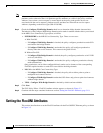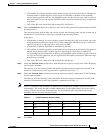
3-12
Cisco IP Solution Center L2VPN and Carrier Ethernet User Guide, 6.0
OL-21636-01
Chapter 3 Creating a FlexUNI/EVC Ethernet Policy
Setting the FlexUNI Attributes
If the check box is unchecked, then you can enter a value during service request creation.
Step 3 Check the Enable PseudoWire Redundancy check box to enable pseudowire redundancy (alternative
termination device) under certain conditions.
Usage notes:
• Enable Pseudo Wire Redundancy is only available if the MPLS Core Connectivity Type was set as
PSEUDOWIRE in the Service Options window (see
Setting the Service Options, page 3-8).
• See Appendix D, “Terminating an Access Ring on Two N-PEs” and, specifically, the section Using
N-PE Redundancy in FlexUNI/EVC Service Requests, page D-3, for notes on how this option can
be used.
Step 4 Check the AutoPick VC ID check box to have ISC autopick the VC ID during service request creation.
If this check box is unchecked, the operator will be prompted to specify a VC ID during service request
creation.
Usage notes:
• This attribute is available only if MPLS Core Connectivity of Type was set as PSEUDOWIRE or
VPLS in the Service Options window (see
Setting the Service Options, page 3-8).
• When AutoPick VC ID is checked, ISC allocates a VC ID for pseudowires from the ISC-managed
VC ID resource pool.
• If MPLS Core Connectivity of Type is VPLS, ISC allocates the VPLS VPN ID from the
ISC-managed VC ID resource pool.
Step 5 Check the AutoPick Bridge Domain/VLAN ID check box to have ISC autopick the VLAN ID for the
service request during service request creation.
If this check box is unchecked, the operator will be prompted to specify a VLAN ID during service
request creation.
Usage notes:
• AutoPick Bridge Domain/VLAN ID consumes a global VLAN ID on the device.
• The bridge domain/VLAN ID is picked from the existing ISC VLAN pool. Once the VLAN ID is
assigned in the service request, ISC makes the VLAN ID unavailable for subsequent service
requests.
• In the case of manual VLAN ID allocation, ISC does not manage the VLAN ID if the ID lies outside
the range of an ISC-managed VLAN pool. In this case, the operator must ensure the uniqueness of
the ID in the Ethernet access domain. If an operator specifies a VLAN ID that is within the range of
an ISC-managed VLAN pool and the VLAN ID is already in use in the access domain, ISC displays
an error message indicating that the VLAN ID is in use.
Note on Access VLAN IDs
An access VLAN ID is of local significance to the FlexUNI-capable ports. It should not be confused with
the global VLANs. This can be visualized as a partitioning of the Ethernet access network beyond the
FlexUNI ports into several subEthernet access domains (one each for a FlexUNI-capable port).
However, all the service interfaces on the Ethernet access nodes beyond the FlexUNI ports will have this
very same VLAN ID for a link. This ID must be manually specified by the operator when setting the link
attributes during service request creation. The operator must ensure the uniqueness of the ID across the
FlexUNI-demarcated Ethernet access domain.
These VLAN IDs are not managed by ISC by means of locally-significant VLAN pools. But once a
VLAN ID is assigned for a link in the service request, ISC makes the VLAN unavailable for subsequent
service requests within the Ethernet access domain demarcated by the FlexUNI. Likewise, if a


















